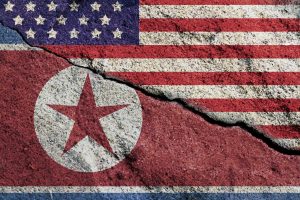South Korean President Moon Jae-in is visiting White House on Friday to hold in-person talks with President Joe Biden. Their parleys may range from reviving trade and commerce to climate change, but much is anticipated from the two heralding their strategy for “complete denuclearization of the Korean Peninsula.” This is only the second in-person summit since Biden took office. Japanese Prime Minister Suga Yoshihide was the first foreign leader to visit the White House on April 16 and, in midst of pandemic, their discussions had also included North Korea.
In this 50th year of the nuclear nonproliferation treaty, as the Biden administration works to revive the 2015 Iran nuclear deal, its much-anticipated review on North Korea policy remains pregnant with a system-shaping promise. However, after the failure of two maximum-pressure summits with former President Donald Trump, the Kim Jong Un regime seems in no mood to return to negotiating. Its recent showcasing of the monster, mobile, MIRVed Hwasong-16 ICBM and Pukguksong-4 SLBMS has only further ratcheted up its rejection of any unilateral denuclearization.
The Biden administration is reportedly in the final stages of its North Korea policy review, which may be announced during the upcoming summit. The White House recently reported that it would prefer to take a middle ground between Trump’s “grand bargain” and Obama’s “strategic patience.” Instead of seeking any dramatic clincher at a leaders’ summit, it wishes to encourage an incremental give-and-take arrangement where each step by Pyongyang toward denuclearization will be reciprocated with corresponding actions like sanctions relief and even security guarantees.
Experts, though, remain skeptical of this incremental approach, fearing the Kim regime will use it to buy time and derail negotiations. The erstwhile Six Party Talks provide the most apt example of this. In his press conference on May 10, Moon sought to refute such doubts by welcoming this incremental approach, saying it was finalized in consultation with Seoul and aims to achieve “the Korean Peninsula’s complete denuclearization through diplomacy with a flexible, gradual and practical approach.” In the midst of pandemic-driven challenges of healthcare, employment, and economic deceleration, and in the face of Moon’s rapidly falling popularity ratings at home, crafting inter-Korean peace remains high on his agenda.
Multiple legacies can be seen pushing this focus on engaging the Kim regime. Moon, in his last year in office, is engaging the United States, strongly guided by his need to craft inter-Korean detente as his legacy. Biden, on the other hand, discounts hectic high-profile summits to allow subtle professional diplomacy to step in. Biden appointing Wendy Sherman as deputy secretary of state last month provides some clues as to what might follow.
As a long-time seasoned diplomat, Sherman has her own legacies. She has a great track record of having been Clinton’s policy coordinator for North Korea and later Obama’s lead negotiator for the 2015 Iran nuclear deal. In May 1999 — when the world was focused on India and Pakistan conducting nuclear tests — Sherman, along with William Perry, was personally hosted by Kim Jong Il and they were “tantalizingly close” to concluding Kim’s non-aggression pact or later a missile pact that could have ended North Korea’s nuclear program. The negotiations were called off by the arrival of new President George W. Bush.
China’s rise has since reshaped ground realities. Biden identifies China — North Korea’s closest ally — as his biggest geopolitical challenge. He hopes to shore up regional allies, which makes him dependent on Japan and South Korea. But the lure of Beijing makes both Seoul and Tokyo cautious about joining the U.S. bandwagon. Hiccups in South Korea-U.S. relations have seen Seoul reluctant to join U.S.-led efforts to promote the free and open Indo-Pacific concept. This clearly contradicts the spirit of their mutual defense treaty where, in case of another Korean war, South Korean forces are expected to fight under U.S. command.
Following the 2016 THAAD fiasco, which cost Seoul at least $7.5 billion in economic losses from Beijing’s unofficial sanctions, the Moon administration had crafted a policy of “strategic ambiguity”, which, during Trump years, gradually titled toward Beijing. Moon remained silent on the Hong Kong protests and Xinjiang interments, and, in spite of repeated exhortations from the U.S. for a ban, allowed LG to engage with Huawei on 5G. Moon has been trying to host Xi Jinping for a summit, which was delayed by the pandemic and now seems unlikely.
Last month, for the first time, Moon even joined China’s flagship Boao Forum for Asia, where he not only endorsed China’s idea of “multilateral cooperation with inclusiveness enhanced” but criticized taking a protectionist approach to guard domestic economies, which he said would end up building a “barrier” to global economic recovery.
However, given that South Korean presidents are limited to a single five-year term, China has traditionally withheld new diplomatic initiatives with South Korea when the president enters a fourth year in office. Also, with less than a year until the next presidential election, the stunning victory of the opposition People’s Power Party in the Seoul and Busan mayor’s elections has further complicated Moon Jae-in’s lame duck presidency.
So with few allies to lean on for Moon, the Biden administration will be left on its own to do much of the heavy lifting in reviving U.S. leadership in nuclear nonproliferation.

































